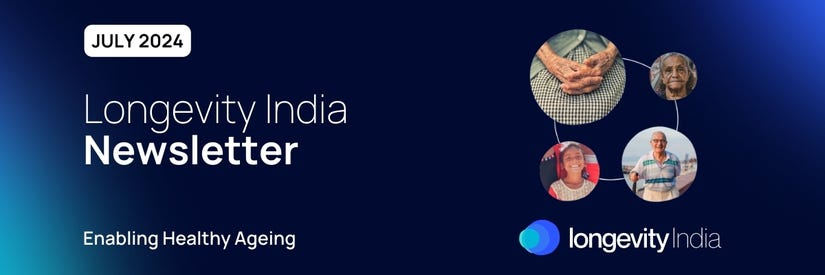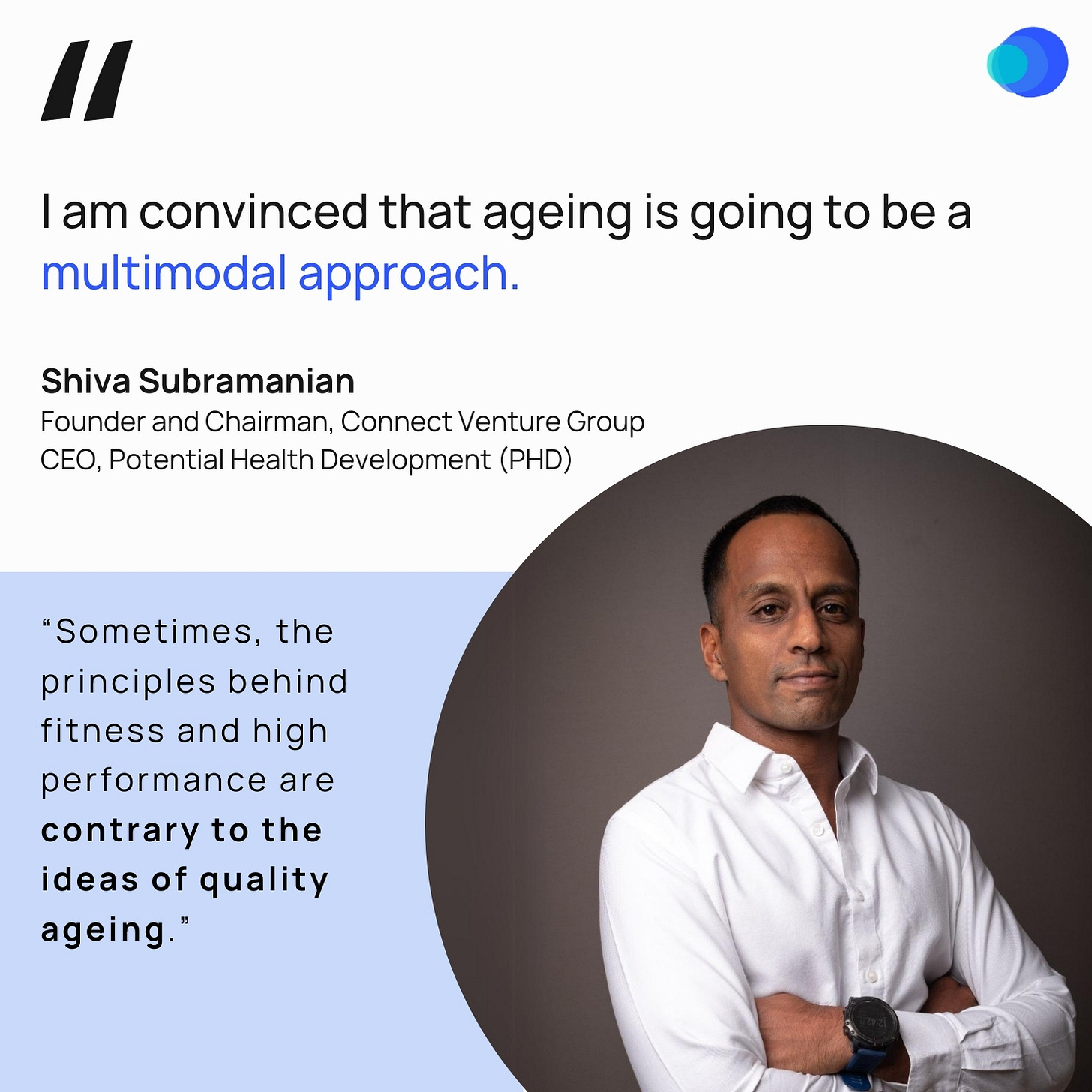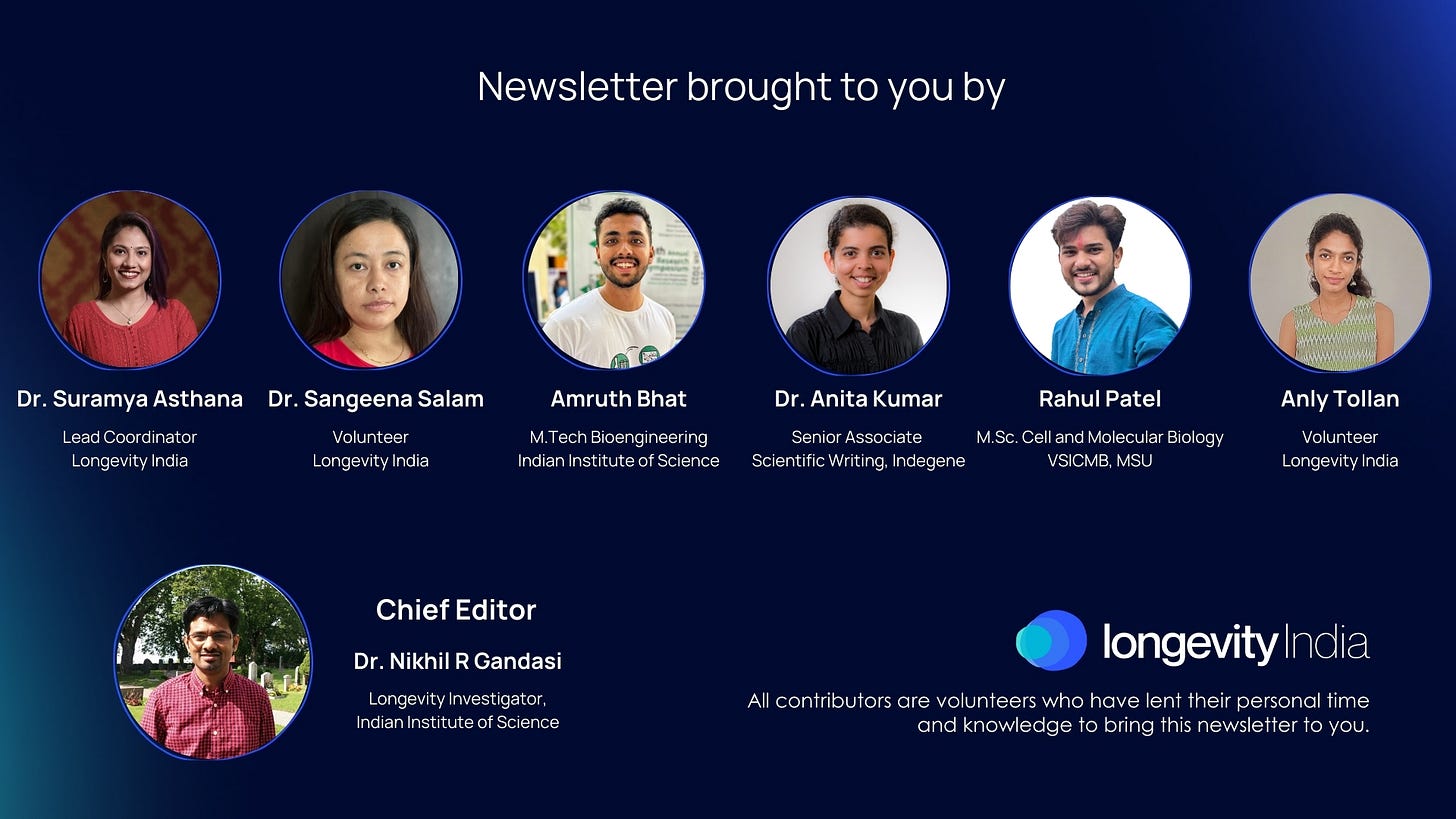Metabolic Ageing: July 2024 (Vol. 1)
This issue of the newsletter brings a special focus on Metabolic Ageing. We feature Shiva Subramanian, latest research on how ketogenic diet affects senescence and a PoC device for metabolic testing.
As we age, our metabolism undergoes profound changes, affecting how our bodies process energy, regulate blood sugar, and maintain cellular health. These shifts can lead to increased risk of age-related diseases, but understanding and addressing metabolic ageing may hold the key to extending healthspan and improving quality of life as we grow older. This issue is focused on metabolic ageing - research, technology and stories from the community.
From the Longevity Community
Meet another star from the longevity community - Shiva Subramanian, Founder and Chairman of the Connect Ventures Group and CEO of Potential Health Development (PHD), who stands at the forefront of India’s impact and sustainability entrepreneurship. He is an alumnus of the United World College of South East Asia and Nottingham University (UK) with expertise in international business and finance. Shiva is globally recognized for his contributions that span business management, impact innovation, food technology, alternative medicine, epigenetics, and bio-degradable polymers. On the personal front, he is a lifelong martial artist and extreme athlete with a holistic philosophy rooted in Bujinkan-Budo-Taijutsu. Here is a deep dive into Shiva’s thoughts on ageing research and the longevity ecosystem!
We asked Shiva what inspired him to focus on longevity research and pursue a wellness-oriented lifestyle:
“My personal interest in the biology of ageing stems from the fact that being supremely fit for a situation, sport, function or activity may not actually have any relevance to the quality of ageing or longevity. Over time, my research and experiences helped me understand that there is a biologically intricate balance that has to be maintained between the practice of performance and the planning required for my marginal decade. Sometimes, the principles behind fitness and high performance are contrary to the ideas of quality ageing resulting in a longer, more fulfilled life.
This idea inspired me to start looking at balancing biological, physiological and neuropsychological metrics, which would translate into a practical wellness quotient.”
Shiva offers plenty of insights into personal wellness through his own experience. He explains that the unique nature of every individual and their DNA leads to infinite possibilities of health expression steeped in each one’s own environmental realities. He emphasizes that any wellness intervention has to be considered as an ‘N of 1’. Talking about his most effective wellness hacks, he went on to elaborate on how he tweaks movement and nutrition to specifically suit his needs:
Movement and Vision
“Due to many years of hard training, I found that a lot of my tissue lacked pliability. So I transitioned into adding softer work involving a lot of fascial and visceral manipulation. For me, this was the softer martial arts - a lot of climbing, twisting and reaching movements on as many multi-dimensional spatial planes as possible. This has also not been a part of my habituated training. For my eye speed, I added a range of racket sports like squash, table tennis and golf.
The idea was simple: I had strength in all my assessments but mobility was going to be the challenge in forecasting my marginal decade. By adding these interventions, my mobility has tremendously improved - potentially avoiding the risk of knee and hip replacements in the future.
My work involves hours of being myopic visually. So, by adding ball sports where I have to track the ball along multiple dimensions, I want to keep all my visual skills such as smooth pursuits, saccades and numerous others intact. The premise is: if you don’t use it, you lose it.”
Nutrition
“The main thing I found was that as a creature of habit, I had minimal diversity in my food even though it was very balanced on the macros. The main thing I realized with testing was that with my lifestyle, my micronutrients were not optimized and nor was my gut microbiome diversity. My Omega 3/6 ratios were also not optimal.
Essentially, what I changed was to increase my diversity of locally grown fruits and vegetables to at least 30 varieties a month.
This was supplemented with nutraceuticals only where required and pulse them only when required. I increased my intake of many local fermented foods which I previously did not have in my diet. Most importantly, I transitioned to cooking only with ghee (clarified butter) or coconut oil.”
But what challenges did he face in this wellness journey?
“Personally, I use objective tools and lab testing of biomarkers to be aware of the internal state of my body. Most importantly, I stay tuned to the way I feel - especially concerning energy and motivation to stay on track.
I am a big fan of wearables. The Ultrahuman ring is one of my favourites. It measures many metrics of my sleep and nervous system every day. As an individual, looking at data allows me to keep things real and respond appropriately.”
Speaking about ageing research, Shiva believes in following many sources, keeping an open mind, and getting to know different points of view on the subject. “Currently, because of some recent exciting conversations, I have been looking into Oxysterols. However, an all-time favourite would be anything around mitochondrial research”, he says.
And does he have a prediction about what approaches and technologies will impact the longevity industry in India in a decade?
“I am convinced that ageing is going to be a multimodal approach and that it is the synergies of collaboration between many specialities that deal with internal biology, biomolecules that influence it, lifestyle, psychology and the modulation of the environment, that will give us the greatest outcomes.
I think we will find that the ’N of 1’ approach will ultimately have the greatest impact. I can also see the scalability of such an outcome easily possible today with the advancement of the myriad digital and data technologies that can easily manage these complex scenarios to actionable outcomes.”
Check out more about Shiva Subramanian’s health experience company, Potential Health Development, which offers an integrated approach to better living.
Ketogenic Diet: A Double-Edged Sword for Cellular Health
Wei SJ et al., Sci Adv. (2024)
Have you ever wondered why some people thrive on a ketogenic diet while others experience negative health effects? The reason lies in the complex interplay between diet, metabolism, and cellular processes. A new study by Dr. David Gius and his team at the Mays Cancer Center and Barshop Institute for Longevity and Aging Studies has shed light on this dietary conundrum.
Published in Science Advances in May 2024, the study investigated the effects of ketogenic diets on cellular health in mice. They compared two groups: mice fed ketogenic diets (90% fat, 9-10% protein, and 0-0.3% carbs) and a control group on a normal diet (58-80% carbs, 10-25% protein, and 10-17% fat).
Here's what they found:
Cellular Senescence Induction: The study discovered that mice on a ketogenic diet experienced cellular senescence across multiple organs, including the heart and kidneys. This was indicated by elevated levels of p53 and p21 proteins. The diet-induced senescence is triggered by activating AMPK and inhibiting MDM2, leading to p53 accumulation and p21 induction.
Key dysregulated pathways: RNA-seq data revealed that p21, p53, and peroxisome proliferator-activated receptor α are upstream regulators on a ketogenic diet. DNA damage pathways were up-regulated, while cell cycle and replication pathways were down-regulated. This suggests potential difficulties in cell division and repair.
Inflammation Markers: Mice on a ketogenic diet showed elevated senescence-associated secretory phenotype (SASP) biomarkers in multiple tissues. This finding was confirmed in human samples from a clinical trial, showing significant increases in pro-inflammatory markers like TNFα and IL-1β after six months on the ketogenic diet.
Reversibility and Prevention: Importantly, the study found that ketogenic diet-induced senescence is time-dependent and reversible. Senolytic treatment or an intermittent ketogenic diet (IKD) could clear away senescence induced by the ketogenic diet, returning to control levels within 2-3 weeks after resuming a normal diet.
How does this study impact our understanding of ketogenic diets?
This research unravels the complex relationship between ketogenic diets and cellular health. It highlights the potential risks of prolonged ketogenic diets while also suggesting ways to mitigate these risks. The finding that senescence induced by sustained ketogenic diets is reversible and preventable through intermittent ketogenic dieting offers a promising avenue for dietary interventions.
Understanding the cellular effects of ketogenic diets can help us tailor dietary recommendations to individual needs. Imagine if we could identify individuals at risk of negative effects from ketogenic diets early on and guide them towards safer alternatives like intermittent ketogenic dieting. This could potentially improve health outcomes and reduce the risk of diet-induced cellular senescence.
As we continue to explore the intricate connections between diet and cellular health, studies like this pave the way for more personalized and effective dietary interventions. The key takeaway? When it comes to ketogenic diets, balance and individual considerations are crucial for reaping the benefits while minimizing potential risks.
Meet the Team
Every issue of the Longevity India Newsletter brings you up, close and personal with the incredible core team driving our mission forward.
In this edition, we are thrilled to shine the spotlight on a talented Postdoctoral Fellow, Dr. Saptadipa Paul, in the “Cell Metabolism” lab
Why ageing research?
I was led into ageing research through my thesis work on diabetes and phytochemistry. During this research, I gained insights into the statistics of age and metabolic disorders, sparking my interest in the broader implications of ageing on health. Our interest lies in understanding the cellular changes involve in glucose metabolism in the aged population which can lead to diabetes. I am exploring active-molecules and its role in managing age-related disorders.
You are currently working on…
We are currently exploring how senescence in pancreatic beta cells affects glucose metabolism and insulin secretion. We are focusing on cellular changes during senescence and their implications for age-related metabolic disorders. Additionally, we are investigating the potential of incorporating small molecules and bioactive compounds to mitigate these effects during cellular senescence with the possibility of improving health in the aging population.
Your goal for Longevity India…
At Longevity India, our aim is to deepen the understanding of metabolic disorders associated with aging and create effective treatment strategies. A key objective is to identify strategies that can prevent the progression from prediabetes to diabetes. Ultimately, we strive to improve the health and quality of life for India's aging population.
Any personal health hacks you follow?
My personal health hacks are regular exercise, including weight training or yoga at least three times a week, healthy eating habits, and avoiding sugar.
anuPath by PathShodh: Point-of-Care Diagnostics for Metabolic Health Monitoring
Metabolic ageing refers to the gradual decline in metabolic function that occurs as individuals grow older. This process involves changes in various physiological parameters, including glucose metabolism, lipid profiles, and hormonal balance. These alterations can contribute to the development of age-related metabolic disorders such as type 2 diabetes, cardiovascular disease, and metabolic syndrome. Monitoring these changes requires regular assessment of multiple biomarkers, which traditionally necessitates access to well-equipped clinical laboratories.
The anuPath device, developed by PathShodh Healthcare, represents an advancement in point-of-care diagnostics for metabolic health monitoring. Emerging from research conducted at the Indian Institute of Science (IISc) in Bengaluru by a team led by Dr. Navakanta Bhat, anuPath integrates multiple diagnostic tests into a single, portable platform.
Some of the key technical features of the anuPath device include:
Multi-analyte testing: anuPath can measure several metabolic markers in a single device:
HbA1c (glycated hemoglobin)
Blood glucose
Hemoglobin
Serum albumin
COVID-19 total antibody
Miniaturization: The device condenses laboratory-grade testing capabilities into a handheld format, measuring 95 mm x 140 mm and weighing 250 mg with batteries installed.
Electrochemical detection: anuPath utilizes advanced electrochemical techniques for analyte quantification, which allows for rapid and precise measurements.
Separate test strips: Each analyte is measured using a dedicated disposable strip, minimizing cross-contamination and ensuring test specificity.
Small sample volume: The device requires minimal blood volume for testing, which is particularly relevant for frequent monitoring scenarios.
Portability: Powered by a rechargeable lithium polymer battery, the device is designed for field use and can operate in temperatures ranging from 15°C to 40°C.
The technical capabilities of anuPath are particularly relevant in the context of metabolic ageing as anuPath's multi-analyte testing provides comprehensive metabolic profiling, enabling the monitoring of key markers and observing how they change with age. Its portability facilitates longitudinal studies, potentially enhancing our understanding of individual metabolic ageing trajectories.
From a technical standpoint, anuPath employs novel electrochemical methods for analyte detection. For instance, the device uses a copper-mediated detection method for glycated albumin (GA), which provides a measure of intermediate-term glycemic control (2-3 weeks) complementing the longer-term information provided by HbA1c.
The anuPath device represents a technical solution for point-of-care metabolic health monitoring. Its ability to measure multiple analytes relevant to metabolic ageing in a portable format has potential applications in both clinical and research settings. As research in metabolic ageing progresses, tools like anuPath may contribute to our understanding of age-related metabolic changes and aid in the development and monitoring of interventions aimed at promoting metabolic health and healthy ageing.
Picture Credits: PathShodh Healthcare Private Limited
Webinar Watch - Click to Register
Job Board
Longevity India is looking for a Community Outreach Coordinator to spearhead the online and offline community management. If you are someone or know someone who might be interested - please look at this post and follow the instructions for applying!
Follow us on Social Media - Click Here
Follow us on Social Media - Click Here
For more information or contributions that would benefit you and the Longevity India initiative, please write to longevity@iisc.ac.in












